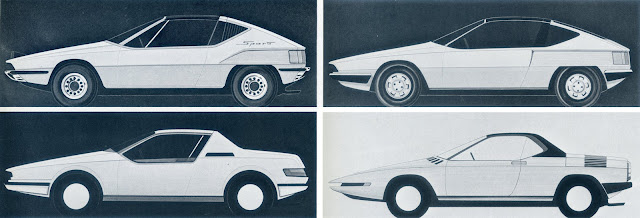With the X1/9 in place, Fiat’s reviews of Pininfarina’s X1/20 from 1973 were conducted on a challenging basis: was there any future for this car/should the project be terminated? Significant investment had been made in this car and there was considerable appreciation of its more traditionally elegant lines as compared with the staccato angularity of the X1/9. Once again, according to an anecdote, Agnelli intervened, directing that the car could and should wear the Lancia marque badge. Finalisation of the design in Spring 1974 was then unimpeded and enabled unveiling as the Lancia Beta Scorpion/Montecarlo at the Geneva show in March 1975. Fiat targeted the U.S. as the primary export market and ‘Scorpion’ was the name chosen to market the car there in its spider form. This was not, however, a conventional drophead – the car simply featured a Pininfarina-patented, large aperture, fabric sunroof, affording targa-style functionality.
Co-opting Gianpaolo Dallara into the process, the Montecarlo body/chassis was drastically revised to create a Group 5-compliant endurance racing car. This was much lighter (at around 770 kgs) than the production model, with fibreglass and aluminium panels substituted for the central cell, combined with spaceframe structures to carry the front end running gear and the rear-located components and aerodynamic appendages. The overall effect, and performance potential was similar to that which Porsche developed with the 934/935 models. In total, 11 pure racing examples of the Montecarlo were constructed.
As to motive power, the standard ‘Lampredi’
1995 cc engine lacked potential for output-uprating in normally aspirated form. Lancia sought to compete in the up-to-2.0
class, for which turbocharged engines were permitted with an equivalency factor-calculated
lower cubic capacity. Abarth’s special
expertise with high performance small engines was called in to collaborate,
resulting in a 1425 cc version of the engine, boosted with a single KKK turbo. On modest boost, this was capable of over 350
bhp and could be run, (but not for too long!), at 23 psi for 415-420 bhp. The car was unveiled at Pininfarina in
December 1978, but it was not until the following Spring that the turbocharged
engine was ready for installation. Race
debut in the hands of Ricardo Patrese and Walter Röhrl was at the Six Hours
event at Silverstone in May, as seen below, (Courtesy of Motorsport Images):
The opening round of the 1980 World Championship for Makes season saw a maximum class points score courtesy of Jolly Club – its drivers, Carlo Facetti and Martino Finotto, finished 10th overall, but well ahead of several Porsche 935s/K3s, including, for example, the Brumos Porsche 935 of Peter Gregg, Hurley Haywood and Bruce Leven. Although the factory team – Lancia Corse – took over the front running for the rest of the season, Montecarlos finished 1-2-3 at four rounds, the Jolly Club entry filling the 3rd place with a strong performance in each instance. The Lancia Corse winning driver pairings were:
|
Race |
Drivers |
|
Brands
Hatch Six Hours |
Riccardo
Patrese/Walter Röhrl |
|
Mugello
Six Hours |
Riccardo
Patrese/Eddie Cheever |
|
Monza
1000 Kms |
Riccardo
Patrese/Walter Röhrl |
|
Silverstone
Six Hours |
Walter
Röhrl/Michele Alboreto |
|
Nurburgring
1000 Kms |
Riccardo
Patrese/Hans Heyer |
|
Watkins
Glen Six Hours |
Riccardo
Patrese/Hans Heyer |
|
Mosport
Six Hours |
Walter
Röhrl/Hans Heyer |
|
Vallelunga
Six Hours |
Riccardo
Patrese/Eddie Cheever |
Lancia 40 points
Ferrari 12 points
BMW 59 points
Porsche 15 points
The car was prepared and run by GS Tuning, founded by Gerhard Schneider as an extension to his BMW dealership business. Located in Freiberg, GS Tuning became a successful motorsport team, especially with the BMW 2002, during the 1970s. Considerable turbocharging expertise was accrued, particularly with the 320 in 1978/9. When Hans Heyer became involved with the team, he encouraged a collaboration with Lancia whereby GS effectively ran the DRM Group 5 Montecarlo on Lancia Corse’s behalf.
Lancia interest in the Italian National Championship remained focused on the Stratos for much of the season. However, at the Magione round in October, Carlo Facetti scored a win for a Montecarlo, ahead of a pair of Stratos and 935s. He then managed 2nd overall and 1st in class at Vallelunga the following month.
An engine development programme provided increased performance potential for the 1981 season. 425 bhp became readily available, increased to 440 bhp using twin turbochargers with the 1429 cc version. Also introduced was a 1775 cc, twin turbocharged unit, putting out 490 bhp.
For
Round 1 of the Championship – now named the World Endurance Championship of
Makes - the 24 Hrs of Daytona, Lancia Corse in the name Martini Lancia
Racing, entered two cars, in a new livery of the drinks-maker, with three-driver
teams of, Riccardo Patrese/Hans Heyer/Henri Pescarolo, and Michele
Alboreto/Beppe Gabbiano/Piercarlo Ghinzani.
A third Montecarlo was once again present, entered by Jolly Club and
driven by Carlo Facetti/Martino Finotto/Emanuele Pirro.
The Jolly Club car finished an excellent 5th overall, 1st in class, whereas both Martini cars suffered engine troubles, resulting in a lowly placing and a retirement.
At the Mugello round, Martini ran a single car, for Patrese/Ghinzani, but this was disqualified as a result of a gearbox failure. Still in Italy, the next round, at Monza, saw four Montecarlos competing. The lead Martini car, driven by Patrese and Cheever, was an early retirement, attributed to engine trouble. The second car, now crewed by Ghinzani and Andrea de Cesaris, also suffered a failure (fuel pump), but having run 129 laps and held the lead, it was classified 13th, 2nd in class. Better than that was the outcome for the private entry, 1979-built car of Germano Nataloni/Gianfranco Ricci, 7th overall and class winner. Jolly Club’s entry for Giorgio Pianta/Beppe Gabbiano/Giorgio Schön retired with transmission trouble just short of half distance.The 1981 Le Mans-winning Montecarlo was sold by Bonhams in 2007 for €225,000 - see www.bonhams.com/auctions/15487/lot/169/






















No comments:
Post a Comment